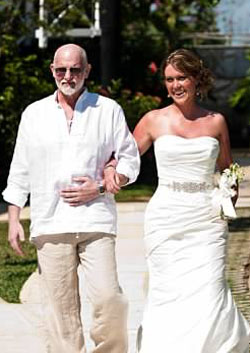By Frank “Duff” Bement, District 6 Construction

Frank “Duff” Bement, District 6 Construction, walks his daughter Amanda down the aisle at her wedding May 20, 2011, in Jamaica. Photo by Debbie Persoon-Bement |
What began as a routine surgery turned into a nightmare I couldn’t have gotten through without the support of my family, friends and incredibly generous co-workers.
On March 3, 2011, I went in to have surgery to remove scar tissue in my lower abdomen. The procedure was considered routine out-patient and I was not going to have to spend any time in the hospital. In order to get to the scar tissue, my intestines needed to be removed. The scar tissue was cleaned up, but as my intestines were being put back two holes were unknowingly punctured in them. The puncture wounds caused me to become septic.
I spent the next 27 days in intensive care, much of which I was unresponsive. I had three surgeries during the first six days I spent in ICU to help with bacterial infections I continued to get.
I lost 40 pounds in 30 days and spent a total of six weeks in the hospital. Even after I was released, I wound up having to go back to the hospital several times because I was continually dehydrated and still losing blood, which prevented me from fully stabilizing.
My daughter Amanda was getting married on May 20, 2011, in Jamaica, and despite the uphill battle I was facing, I was determined to be there to walk her down the aisle.
My supervisor helped get me on the vacation donation list and what followed was simply amazing. I received a total of 989 hours not only from District 6 employees, but from people in other districts, people I haven’t seen in years, and even people from other state agencies.
Since there was such a large amount of time that I wasn’t responsive while in ICU, it made my wife feel better knowing that we had these additional hours to fall back on in case my recovery exceeded the vacation and sick leave I had accrued.
I was off work until June 30, when I came back for two half days until the shutdown. After the shutdown I was able to come back to work full-time.
I want to express my deep gratitude to everyone who donated time to me. While I only needed to use a portion of the donated time, every hour that I didn’t need went back into the pool to help someone else.
This vacation donation program works—I am living proof of it. I now plan to donate 40 hours each year to the “vacation donation bank” as a way to repay what I used and help someone else out.
My final hospital visit was April 26 and we left for Jamaica May 17. I wasn’t able to go in the ocean or sit in the sun while we were there, but I got to walk Amanda down the aisle, which is all that mattered.
Editor's note: The state vacation donation program allows employees to donate up to 40 hours of vacation per fiscal year for approved recipients who have exhausted their sick and vacation leave due to illness.
To donate vacation hours, go to the Employee Self Service Website and click “Other Payroll” and then “Leave Donations.” The site also allows employees to view a list of all state employees eligible for the program and enroll as a recipient. |



